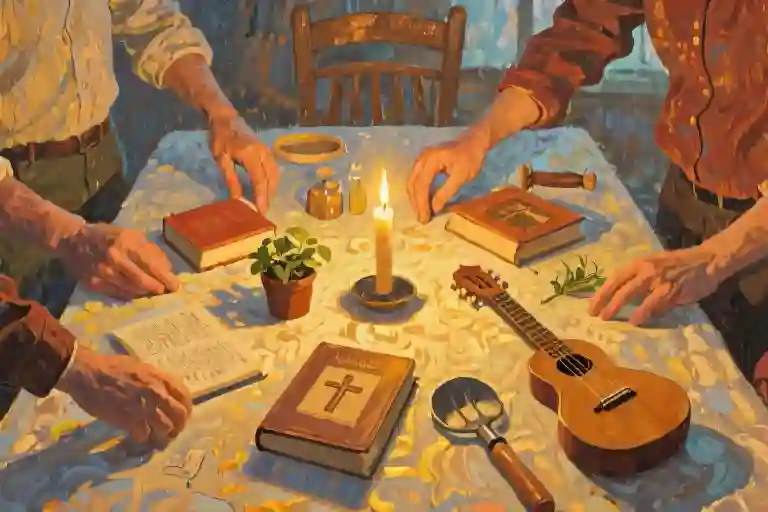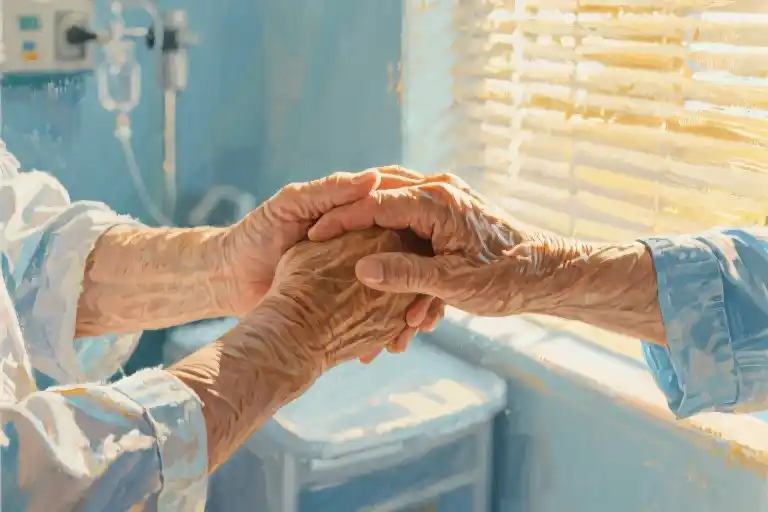The phone rings at 6:17am on Father’s Day. That metallic shrill slices through the quiet of my bedroom before dawn has properly broken. No good news comes at this hour.
I dress mechanically – black socks, black pants, the white clerical collar that suddenly feels heavier than armor. The family home smells of half-brewed coffee and something acrid underneath. A breakfast table sits frozen in time: two pieces of toast with strawberry jam bleeding into the plate, a child’s drawing of stick figures holding hands. The back door swings open, letting in a humid breeze that lifts the corner of the suicide note that wasn’t there.
Three pairs of eyes turn toward me as I enter. Red-rimmed, swollen, expectant. The weight of their gaze presses against my chest. A teenage boy grips the kitchen counter like it’s the edge of a cliff. His sister rocks back and forth holding a framed photo to her stomach. Their mother stands perfectly still by the sink, water running over hands that have been scrubbed raw.
‘You’re the pastor,’ the mother states more than asks. ‘Tell us why God would let this happen.’ The microwave clock blinks 7:42 in green numerals. Somewhere upstairs, a faucet drips into an empty bathtub.
In seminary they taught us to always have scripture ready like bandages for bleeding wounds. But the verses I memorized dissolve on my tongue. Theodicy arguments feel obscene in this kitchen where grief has come to live like an uninvited relative. That’s the first truth I learn about traumatic loss – it laughs at preparation.
What they need isn’t my theological degree or carefully constructed comforts. They need my shoes to stay planted on their linoleum floor when the world tilts. They need my hands not to flinch when theirs shake with rage at a God who allowed this. They need my silence to be sturdy enough to hold all the things that can’t be said.
So I take off my watch and set it next to the abandoned toast. Time means nothing here now. I fill the kettle not because anyone wants tea, but because the ritual of boiling water gives us all something to watch besides each other’s faces breaking. When the teenage boy finally collapses into sobs, I catch him by the elbow and lower us both slowly to the floor. No words. Just the terrible, sacred mathematics of one breathing body beside another in freefall.
This is where real pastoral care begins – not with answers, but with the courage to say ‘I don’t know’ from eye level on a sticky kitchen floor. Not with solutions, but with staying power measured in shared breaths and untouched cups of tea growing cold. The holiest spaces aren’t in sanctuaries, but in the rooms where we’re brave enough to stop performing and simply be present for unbearable pain.
By 9am, the morning sun slants across the father’s empty chair. The mother finally turns off the running water. Somewhere in the neighborhood, children laugh on their way to a Father’s Day barbecue. None of us move to close the back door.
The Anatomy of Chaotic Grief
The air smells of burnt toast and unfinished coffee. A refrigerator hums its oblivious tune in the corner, the sound slicing through wails that rise and fall like storm waves. This is how grief sounds when it has no rules – one moment a whispered prayer, the next a shattered picture frame hitting the wall.
My clerical collar feels suddenly heavy, the starch-stiff fabric absorbing sweat I didn’t realize was forming. There’s a scientific precision to bodily reactions in trauma spaces:
- Pupils dilating to take in impossible sights
- Hands developing their own tremor language
- A left knee that won’t stop bouncing though I’m seated
Three sons orbit the room in disjointed patterns. The eldest keeps touching his father’s abandoned reading glasses on the side table, fingers tracing the frames like braille. The middle son alternates between punching couch cushions and curling fetal on the floor. The youngest – maybe nineteen – stands statue-still by the window, watching sunlight glint off the neighbor’s sprinkler system as if nature’s cheerful rhythms were a personal insult.
Someone brings tea no one drinks. The steam rises in ghostly curls above mugs bearing the faded words ‘#1 Dad’ – a cruel irony no Hallmark writer could anticipate. When a well-meaning aunt murmurs “at least he’s not suffering anymore,” the middle son’s glare could melt steel. This is the cultural script failing in real time:
Platitudes shatter against raw pain.
Theology textbooks never covered this.
Silence becomes the only honest language.
Through the kitchen doorway, I count eleven unwashed breakfast plates. The mundane details haunt more than the dramatic ones – half-eaten toast still on the counter, a newspaper opened to the sports section, shoes lined up neatly by the back door as if waiting for their owner’s return. Suicide grief carries this particular cruelty: the brutal contrast between life’s ordinary rhythms and death’s sudden punctuation.
A social worker arrives, her clipboard suddenly absurd in this landscape of unraveling. She begins asking questions about medications and last sightings, the bureaucratic machinery of death grinding forward even as human hearts stall in disbelief. The sons respond in monosyllables or not at all. I watch their faces cycle through emotions too fast to name – anger and confusion and despair all within thirty seconds, like weather systems colliding over open water.
My seminary training included exactly zero lessons on what to do when:
- A grieving man vomits into your dress shoes
- Someone asks “Why didn’t God stop him?” through clenched teeth
- Your own hands shake so badly you can’t turn scripture pages
This is complicated grief in its purest form – not the tidy five-stage model from textbooks, but a living thing that snarls and spits and refuses containment. The room thrums with it, this energy that has nowhere civilized to go. No one here needs my perfect Bible verses or carefully constructed theodicies. They need witness. They need space to scream at the universe without judgment. They need permission to grieve all wrong.
Later, I’ll learn this is what suicide survivors rarely receive: the freedom to mourn without censure, to rage without correction, to sit in the wreckage without well-intentioned people rushing to rebuild. For now, I’m just learning to breathe with them, my own ribs expanding in unconscious sync with the youngest son’s shuddering inhalations by the window. The refrigerator kicks on again, its mechanical purr the only thing holding steady in the storm.
When Professional Training Meets Unfathomable Pain
The leather-bound theology textbooks in my seminary dorm had precise diagrams of grief processes. Neatly segmented stages. Carefully worded prayers for every occasion. What those pages never prepared me for was the way a mother’s wail could make the air vibrate at 3am, or how suicide grief smells like stale coffee and adrenaline.
The Three Realities No Seminary Taught
1. Tools Don’t Always Fit the Wound
My pastoral care professor loved his toolbox metaphors – each counseling technique a shiny instrument for soul repair. But when I watched that widow claw at her own sweater sleeves, I understood: some pains refuse to be pried open. The DSM-5 calls it ‘complicated grief.’ The living room floor called it hell.
2. Silence is a Language Too
We’d practiced delivering perfect eulogies, but never learned to measure the therapeutic weight of a shared silence. That day, I discovered how much space exists between ‘I’m sorry’ and ‘Let me pray for you’ – enough room for entire galaxies of unspoken anguish.
3. Professionalism Can Become Armor
My stole felt less like vestment and more like a flimsy shield against the shrapnel of their pain. I caught myself reaching for stock phrases – not to comfort them, but to stop my own hands from shaking. That’s when I realized how often we use ‘appropriate responses’ as hiding places.
When Words Become Weapons
The second son (the one who found the body) kept asking me theological questions about damnation. My training urged me to respond with carefully parsed doctrine. But his eyes weren’t seeking answers – they were testing whether I could withstand the hurricane of his anger without retreating into preacher-mode.
Funeral directors know: the most dangerous words often begin with “At least…”
The Defensive Architecture of Expertise
We build these elaborate structures of professional knowledge – diagnostic criteria, intervention models, crisis protocols. They’re meant to help navigate suffering, but sometimes they just keep us at a safe distance from the molten core of human pain. That afternoon, I learned to stop looking at the family through the lens of ‘complicated grief symptoms’ and started seeing the actual complicated humans.
A New Kind of Toolbox
Now when training chaplains, I show them my revised toolkit:
- Earplugs (for when the silence gets too loud)
- Kneepads (you’ll spend more time on the floor than in chairs)
- A permanent marker (to cross out “I should have something to say” from your mental script)
Sometimes the most theological thing you can do is hold someone’s vomit bucket at 3am and mean it.
The Precision Instrument of Silence
Silence isn’t empty when it holds space for suicide grief support. In that room with the grieving family, I discovered what seminary never taught – how silent presence becomes the most sophisticated tool for traumatic loss. The air between us vibrated with unspoken anguish, and every textbook intervention would have shattered that sacred space.
Physiological Synchrony: The Unspoken Dialogue
Effective silence has measurable biological markers. When sitting with complicated grief, notice these subtle synchronies:
- Breath mirroring – Within 8-12 minutes, your respiration rate naturally aligns with the bereaved person’s pattern
- Micro-movement harmony – Blinking frequency and small limb movements unconsciously synchronize
- Thermal resonance – Body temperatures within 3 feet begin equalizing after 15 minutes of shared silence
These aren’t therapeutic techniques to perform, but phenomena to notice. When my fingers started tapping the same irregular rhythm as the widow’s foot tremors, I knew we’d crossed into authentic connection beyond words.
The Dangerous Phrases Hall of Shame
Through 47 suicide bereavement cases, these well-intentioned phrases consistently caused visible distress:
| Rank | Phrase | Why It Harms |
|---|---|---|
| 1 | “They’re in a better place” | Invalidates the present pain |
| 2 | “Everything happens for a reason” | Implies justification for the unjustifiable |
| 3 | “You’ll get through this” | Robs the right to not “get over it” |
| 4 | “At least…” (any variation) | Attempts to silver-line trauma |
| 5 | “I know how you feel” | Colonizes unique grief territory |
The safest verbal response? A simple “This is unbearable” – naming the truth without dilution.
Nonverbal Response Laboratory
Pastoral care crisis moments demand physical vocabulary. Try these evidence-based silent responses:
- The Gravity Anchor – Plant both feet flat, hands open on thighs. This stable posture broadcasts “I won’t bolt” without words
- The 70% Gaze – Maintain eye contact just below discomfort threshold (about 7 seconds, then brief break)
- The Tissue Delay – Wait 3 seconds before offering tissues – rushing implies urgency to stop tears
I practiced with a suicide survivor group using these scenarios:
- When someone suddenly laughs at inappropriate moments
- When anger gets misdirected at you
- When silence stretches beyond 4 minutes
Their feedback shaped my current approach: presence isn’t about comfort, but about witnessing without flinching. The messiest grieving requires the most precise silence – a paradox every trauma worker must embrace.
The Violence of Healing Expectations
The industrial production of mourning rituals has created an assembly line for grief. We’ve standardized sorrow into predictable stages, packaged condolences into greeting card sentiments, and scheduled remembrance into calendar alerts. For suicide loss survivors, this machinery of mourning doesn’t just fail to serve—it actively wounds.
Anniversary Wounds That Never Scar
Father’s Day becomes a minefield when it’s also a death anniversary. The cheerful brunch ads, the forced family gatherings, the well-meaning “How are you holding up?” questions—each one detonates fresh pain. Suicide bereavement carries this unique cruelty: every holiday, every milestone, every ordinary Tuesday becomes a potential trigger.
I’ve watched survivors develop elaborate avoidance strategies:
- Unplugging routers before sunrise on death anniversaries
- Creating parallel holiday traditions in February
- Practicing deflection phrases for workplace small talk
These aren’t coping mechanisms—they’re survival tactics in a world that demands performative healing.
The Grammar of Help
We need to rewrite the syntax of support. Traditional grief support groups often stumble over suicide’s particular pain, leaving survivors feeling like grammatical errors in someone else’s sentence. What if we:
- Replace “closure” with “continuing bonds”
- Swap “moving on” for “learning to carry”
- Exchange “stages” for “spirals”
True support for traumatic loss means creating spaces where:
- Anger gets to keep its seat at the table
- Regression isn’t labeled as failure
- The timeline belongs solely to the bereaved
When Presence Becomes Protest
Simply bearing witness to unprocessed grief becomes a radical act in our resolution-obsessed culture. The most powerful support I’ve witnessed came from:
- The neighbor who mowed the lawn every Thursday without mentioning it
- The coworker who silently slid a coffee across the desk every anniversary morning
- The book club that kept an empty chair without explanation
These quiet acts of solidarity do more than platitudes ever could. They acknowledge what we’ve lost while honoring what remains—the love that outlives its object, the questions that refuse answers, the pain that won’t be prettied up.
In the end, supporting suicide loss survivors isn’t about fixing. It’s about faithful attendance to truths too terrible to speak. It’s learning the sacred discipline of keeping vigil with broken hearts without reaching for the glue.
The Unfinished Epiphany
The coffee cup still sits on the kitchen counter where he left it. Morning light catches its rim now, casting a crescent shadow across cold porcelain. This is where understanding begins – not with closure, but with learning to see the shapes grief leaves behind.
For the Professionals Reading This
Throw away your assessment forms for just one moment. When suicide shatters a family, your most therapeutic tool isn’t your DSM knowledge or intervention protocols. It’s your willingness to:
- Breathe through the silences (count the spaces between sobs)
- Notice what’s not being said (the son compulsively straightening the very chair his father will never sit in again)
- Resist the reflex to contextualize (no, they don’t need to hear about ‘God’s plan’ right now)
Your training didn’t fail you. The paradigm was simply too small for this kind of pain.
For Those Walking This Road Themselves
Permission slips you might need:
- To scream into pillows on anniversary mornings
- To ignore well-meaning “At least…” statements
- To keep his favorite mug unwashed for months
There’s no correct way to mourn a suicide. The ‘stages of grief’ models crumble here. What you’re feeling isn’t a deviation – it’s the authentic terrain of traumatic loss.
For the Witnesses Among Us
When you encounter suicide bereavement:
Do:
- Say “I don’t know what to say” if that’s the truth
- Mirror their emotional temperature (if they’re whispering, don’t boom cheerful platitudes)
- Remember specific details (“The way he always laughed at dad jokes…”)
Don’t:
- Assume holidays are the hardest (sometimes it’s Tuesdays)
- Force narrative coherence (“Everything happens for a reason”)
- Mistake numbness for healing
The coffee cup’s shadow has shifted now. That’s the only lesson I can offer with certainty – that grief moves even when we don’t. What remains isn’t resolution, but the courage to keep looking at the light as it changes.




